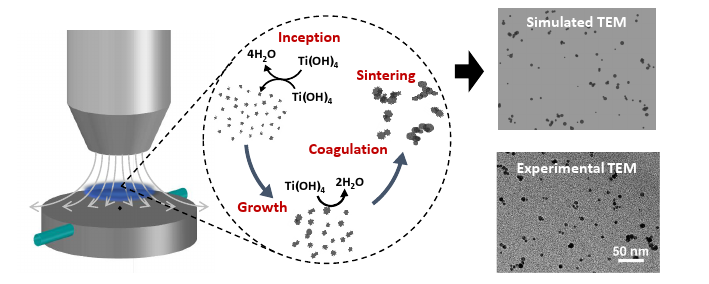Technical Report 226, c4e-Preprint Series, Cambridge
Numerical simulation and parametric sensitivity study of titanium dioxide particles synthesised in a stagnation flame
Reference: Technical Report 226, c4e-Preprint Series, Cambridge, 2019
- A detailed PBM is used to simulate titania nanoparticles synthesised in a stagnation flame.
- Simulated TEM-style images are compared to experimental TEM measurements.
- A parametric sensitivity study is performed.
- The sintering behaviour of nano-sized particles is investigated.
 A detailed population balance model is used to simulate titanium dioxide nanoparticles synthesised in a stagnation flame from titanium tetraisopropoxide (TTIP) precursor. A two-step simulation methodology is employed to apply the detailed particle model as a post-process to flame profiles obtained from a fully coupled simulation with detailed gas-phase chemistry, flow dynamics and a simple particle model. The detailed particle model tracks the size and coordinates of each primary in an aggregate, and is able to resolve the particle morphology, permitting direct comparison with experimental measurements through simulated TEM-style images. New sintering parameters, informed by molecular dynamics simulations in the literature, are introduced into the model to account for the sintering behaviour of sub-10 nm particles. Simulated primary and aggregate particle size distributions were in excellent agreement with experimental measurements. A parametric sensitivity study found particle morphology to be sensitive to the sintering parameters, demonstrating the need to apply careful consideration to the sintering behaviour of nano-sized particles in modelling studies. The final particle morphology was not found to be sensitive to other model parameters.
A detailed population balance model is used to simulate titanium dioxide nanoparticles synthesised in a stagnation flame from titanium tetraisopropoxide (TTIP) precursor. A two-step simulation methodology is employed to apply the detailed particle model as a post-process to flame profiles obtained from a fully coupled simulation with detailed gas-phase chemistry, flow dynamics and a simple particle model. The detailed particle model tracks the size and coordinates of each primary in an aggregate, and is able to resolve the particle morphology, permitting direct comparison with experimental measurements through simulated TEM-style images. New sintering parameters, informed by molecular dynamics simulations in the literature, are introduced into the model to account for the sintering behaviour of sub-10 nm particles. Simulated primary and aggregate particle size distributions were in excellent agreement with experimental measurements. A parametric sensitivity study found particle morphology to be sensitive to the sintering parameters, demonstrating the need to apply careful consideration to the sintering behaviour of nano-sized particles in modelling studies. The final particle morphology was not found to be sensitive to other model parameters.
Material from this preprint has been published in Journal of Aerosol Science.
PDF (7.2 MB)



